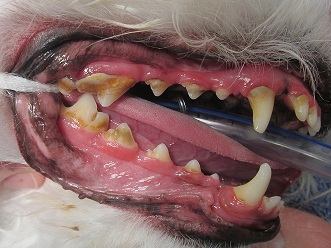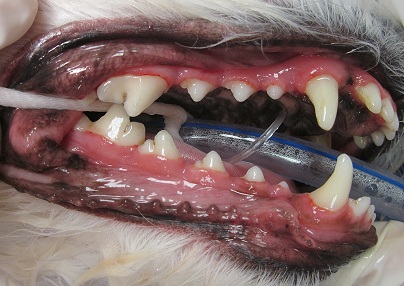Dentistry
One of the most overlooked aspects of preventative health maintenance is dental care for your pet. Eighty-five percent of dogs and cats develop periodontal disease by the age of 3 years. Many of these problems are very slow in their onset. A gradually increasing reluctance to eat, bad breath, loss of energy, and reluctance to play are a few of the signs that point to dental disease.
|
Before Dental Prophylaxis

|
After Dental Prophylaxis

|
What is periodontal disease?
Periodontal disease is the most common cause of dental problems. Periodontal disease starts as bacterial growth on the surface of the tooth and the pocket of tissue around the teeth. The bacteria then enter deeper into the soft gum tissue and destruction of the connective tissue begins. As the tissue loss continues, the pocket deepens. A hard calcium deposit called calculus forms around the base of the tooth. At this stage serious problems occur. The bone holding the tooth in place recedes and the tooth becomes painful as it loosens. The infection in the gums results in a discharge of bacteria and toxins into the blood stream, which can spread to the liver, heart, and kidneys.
Treatment
All dogs and cats should have an exam twice yearly. The oral cavity will be closely examined for calculi, pain, or redness of the gums. If periodontal disease is found, a professional cleaning and polishing will be recommended to restore the teeth and gums to health. All animals must be anesthetized for a proper dental cleaning with ultrasonic scaling and polishing. Our hospital has a special radiology machine that can take dental xrays to determine if a tooth is healthy or needs to be removed. We are also able to do extractions and minor oral surgery, such as biopsies and removal of oral masses.
Prevention
Home dental care is very important in preventing periodontal disease. We recommend daily brushing as our first line of defense for this preventable disease. Introduce a brushing program to your pet gradually. At first, dip a finger into pet dental toothpaste and rub gently over the pet's mouth and teeth. Make the initial sessions short and positive. Gradually introduce gauze over a finger and gently scrub the teeth in a circular motion. Finally, you can introduce a soft or pet-specific toothbrush. For pets that will not tolerate routine brushing, we recommend C.E.T. chews, special dental diets, and water additives. Look for products that have a VOHC (Veterinary Oral Health Council) seal of approval for additional preventive care options.
|